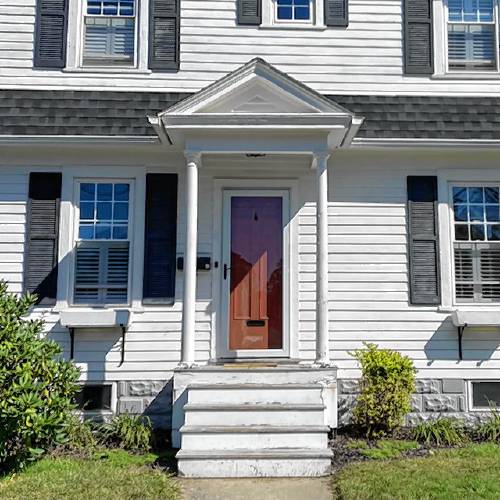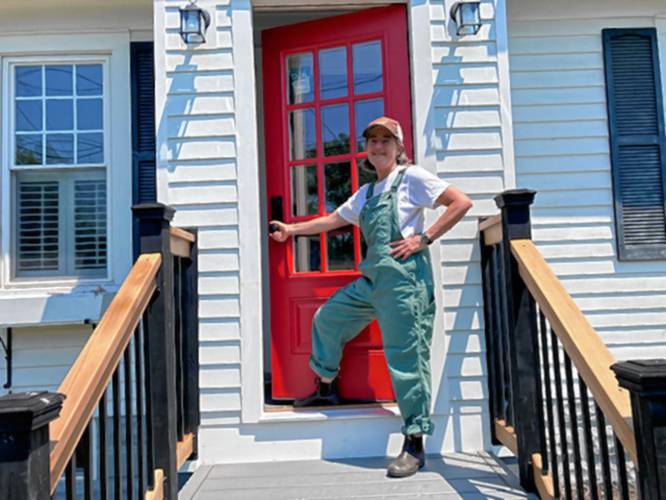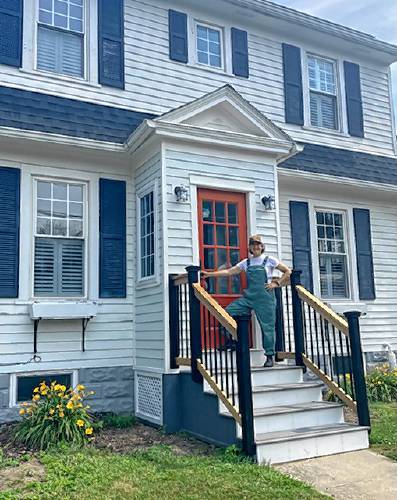An entryway and a whole new skill set: Greenfield homeowner took a hands-on approach to her dream project, and it paid off
| Published: 07-08-2024 4:01 PM |
Donna Riggs goes by the nickname Lucky, and the first-time homeowner feels fortunate indeed. Riggs, 63, heartily contributes to making her own luck, and did so this spring by participating in the replacement of her home’s entryway. As a result, the recent transplant to Greenfield now has the enclosed vestibule of her dreams, and a whole bunch of new skills under her belt. Tool belt, that is.
Before embarking on the rehab project, Riggs — a Rhode Island native who returned to New England following decades in Santa Cruz, California — said she “didn’t know a nail gun from a screw gun. I really had no clue.”
Her involvement in the building process sprang from necessity. “I got a bunch of estimates, and they were all out of my ballpark. The entryway definitely needed replacing, so I had to get creative.” Riggs asked a friend for a referral; that’s how she met Easthampton craftsman Ed Cohen. “Ed gave me a quote that fit my budget,” she said. “He did so by agreeing to do the labor for a flat fee, with the caveat that I would work alongside him, doing a lot of the prep.” Cohen’s willingness to be flexible meant that, in addition to the job getting done at a price she could afford, Riggs learned practical skills that will stand her in good stead as a homeowner.
Before getting started, Riggs hopped on her bike and pedaled around Greenfield neighborhoods, hoping to find a vestibule that resembled the design she could picture in her mind. “I knew I wanted the front door to have an ample window with three [panes] over four so I could sit there comfortably even in wintertime, and have plenty of light. I could imagine myself in a beautiful space, gazing out on my lovely neighborhood while drinking a cup of coffee.” Even though Riggs didn’t find anything around town that matched what she envisioned, she was able to describe it to Cohen.
Riggs and Cohen drew up plans and established their work schedule week to week. “Whenever possible, we worked on Mondays and Tuesdays, my days off,” said Riggs, who works part-time for the Connecticut River Conservancy. “But sometimes we had to reschedule due to rain.” Each time Cohen arrived for a work stint, Riggs had materials ready for action. “I was like Ed’s surgical assistant,” said Riggs. “I saved him a lot of time since he didn’t have to go up and down the ladder. He’d tell me what he needed, and I’d get it for him.” Riggs was also responsible for picking up building materials.
“Ed would text me when he was on his way, and I’d set everything up in the shade. It was win-win,” said Riggs. “We looked at the project together and got to enjoy the day.” The work involved numerous aspects: “Measuring, leveling, wow, the stuff I learned,” said Riggs. “What it takes to build something: there are so many details! I now have much more appreciation for what it takes to create a structure, no matter how small.”
Riggs said that if she’d had the financial ability to go the conventional route, she would have missed out on a thrilling experience. “If I’d paid for a design-build, and said, please just make that go away and replace it, I would have missed out on so much, like how to spot and avoid bowed lumber. The process was so cool because, for decades, every time I’d go to a hardware store, I was mesmerized by the variety of screws and nails. I’d wonder, why are there so many different kinds? Now I know why. It’s amazing.”
In addition to learning about footings, disconnecting the compressor, and loading and using nail guns, Riggs got up to speed with aspects like the permitting process. “I had to do that in person,” she said. “Fortunately, the DPW is right around the corner.” Cohen specializes in custom woodworking, and while he’d never built an enclosed entry, he was curious about using techno posts. “Of course, I didn’t even know what techno posts were,” said Riggs. Also known as Techno Metal Posts, they’re a modern foundation solution involving a helical pile that screws into the ground until it reaches the appropriate depth to support the load in question. (Helical means having the shape of a helix or spiral.)
Article continues after...
Yesterday's Most Read Articles
“The first thing I had to do for the permitting process was to see if the existing footings were OK,” said Riggs. “I bought a shovel, started digging, and found that the footings were only three feet deep.” Riggs sent a photo to the inspector, who informed her that the existing infrastructure was inadequate. After jumping through all the right hoops, Riggs acquired a permit last September; demolition began several months later, in April. “First, we had to erect a temporary structure to keep the roof up. Once that was done, we pulled the old thing down. I got to use a sawzall,” said Riggs gleefully, using a popular term for a reciprocating saw, which is considered a go-to tool for remodeling and demolition, due to its usefulness in cutting through all sorts of lumber, even stuff that’s embedded with nails. (Anyone who’s used a sawzall can attest to the wonderful feeling that can result from using a tool that can also slice through many common forms of metal, including steel, aluminum, copper, and cast iron.)
“Then the rains came,” said Riggs. “It finally dried out enough to put in the techno posts. We didn’t have to dig out the old footings, which saved us about a week’s work. The new posts were eight feet tall, and just screwed in. It took (the installer) about 30 minutes. The posts were $250 each, but in the long run, we saved so much time. We didn’t even have to pour cement.”
Cohen gave Riggs a lumber purchase list. “Then Ed would show up, unload a chop saw and table saw. I’d set up a ladder for him,” said Riggs. “He cut the lumber to size, and we got busy.” Riggs discovered that she loved shopping for supplies. “Sometimes I went to Home Depot, and other times to an outlet in West Hatfield called rk Miles. That place is like a toy store for me,” she said. “There’s an area displaying windows, an area for porch railings, another for doors, even one for door knobs. Then there are all the supplies: Screws! Zip tape! Sheet rock! I loved it.”
As the project neared completion, the crew of two stepped up their work schedule to three days a week. “I still have a few tasks left,” said Riggs, “but [the new structure] is a thing of beauty.” She beamed with pride as she stood in her vestibule, which at approximately 34” deep and 56” wide somehow manages to look spacious. “I call it the world’s smallest atrium,” she said.
The story of how and why Riggs moved back east is a whole other saga, one that strikes a chord all too familiar in today’s tough housing market. The adventures that led to her acquiring her current home is the stuff of legends, but would require a whole other column, replete with disappointing open houses, nail-biting waiting periods, and ultimately an ecstatic late-night call from her realtor. Once the process got rolling, however, “Everything was effortless,” said Riggs. “After a difficult period, things just started clicking, like it was meant to be.” She added, however, that “buying a house is one of the biggest things you’ll ever do, and in this market, you have to make an almost instant decision. Then there’s tons of maintenance. It’s like having a kid.”
There are a few tasks left before the vestibule is complete. “I still have to caulk, putty, spackle, and sand the interior,” said Riggs. “Then I’ll paint the interior. I already painted the exterior of the front door, and can you believe it? It turned out the least expensive exterior lights were actually the cutest!”
Riggs’s enthusiasm is as sparkly as her new vestibule. Now that the project is nearly complete, Riggs looks forward to other DIY endeavors. “I took a woodshop class in California, but I didn’t own any tools. Now I want to use scrap wood left over from the vestibule to make more stuff.” She pointed to a few things she’s already made: “A bulletin board, a potato box, and a bench.”
Riggs is grateful that Ed Cohen was willing to take a chance on working alongside an enthusiastic but largely unskilled client. “It worked out great,” she said. And she’s thrilled that her new place is in a bike-friendly town that also has a farmers market. “I love Greenfield,” she said. “I’m here to stay.”
Eveline MacDougall is the author of “Fiery Hope,” and a former tradesperson. She can be reached at eveline@amandlachorus.org.









 Putting the students front and center: What can education can look like without high stakes testing?
Putting the students front and center: What can education can look like without high stakes testing? Sounds Local: He’ll play anything you want: Stephen Kellogg will perform an all-request show at Shea Theater, Dec. 19
Sounds Local: He’ll play anything you want: Stephen Kellogg will perform an all-request show at Shea Theater, Dec. 19 Speaking of Nature: Introducing the Birch Perch II: Making improvements to my bird observation venue
Speaking of Nature: Introducing the Birch Perch II: Making improvements to my bird observation venue Conversations over candy-making: Sharing beloved holiday food traditions
Conversations over candy-making: Sharing beloved holiday food traditions
